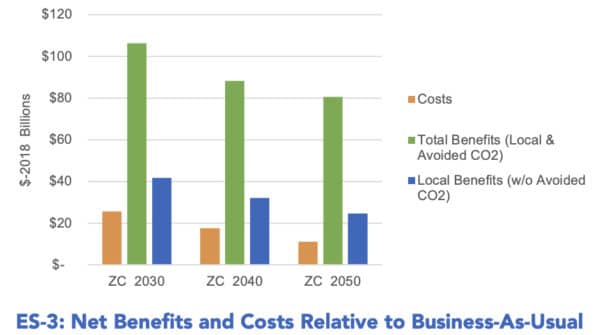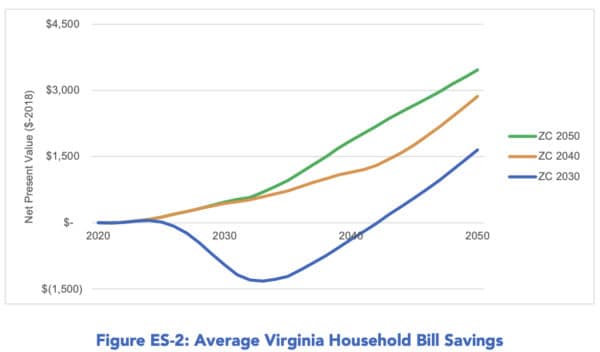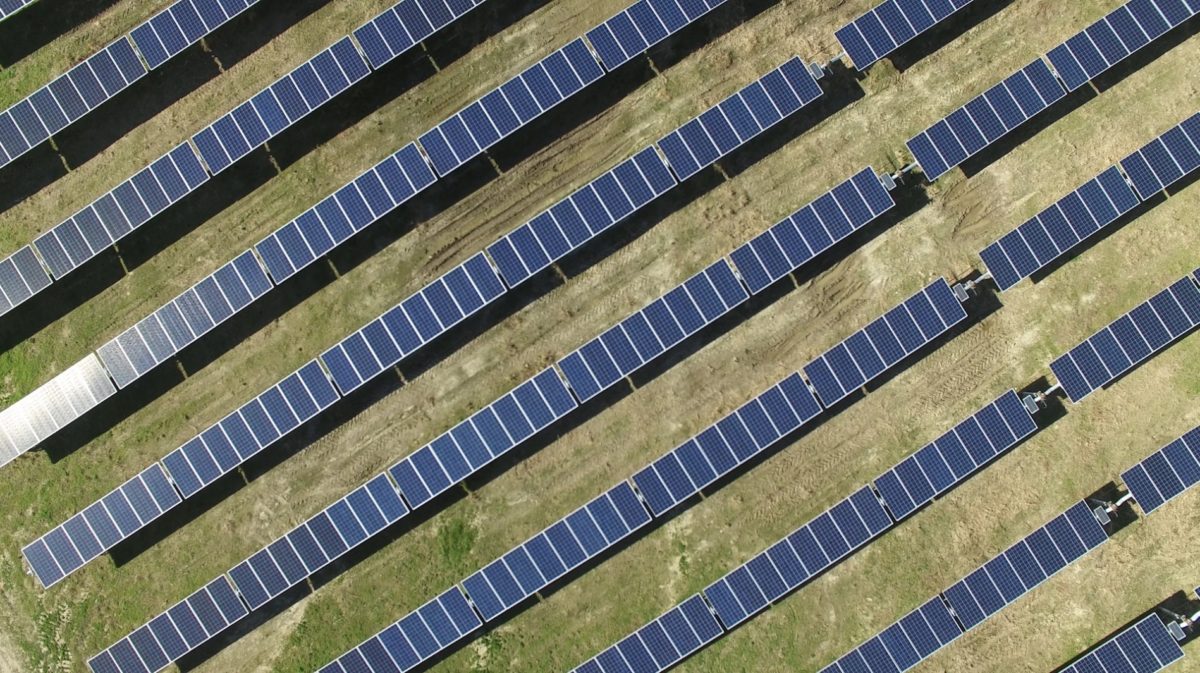As the utility Dominion Virginia drags its feet on the renewables transition, a clean energy group has called its bluff, running independent modeling showing that renewables would save consumers money.
Virginia consumers would see lower bills every year through 2050 if the state’s utilities added 49 GW of solar over that time period, matched with “over 20 GW” of storage, to reach 100% zero-carbon generation by 2050.
That would be about three times the amount of solar expected in “business as usual” utility plans, according to a study, Virginia’s Energy Transition, commissioned by Advanced Energy Economy. In the “business as usual” case, derived from Virginia utilities’ integrated resource plans, Virginia would still have more than 20 GW of coal and gas in 2050, and just 20 GW of renewables.
The Virginia study was conducted by the Greenlink Group to evaluate reaching 100% zero-carbon generation by 2030, 2040, or 2050. It follows similar independent utility modeling for Georgia and North Carolina.
Employment would increase in the zero-carbon scenarios, due to energy efficiency contracting and deployment of renewables and storage; job creation would exceed “business as usual” by an average of 7,000 to 11,000 jobs per year.
Advanced Energy Economy (AEE) commissioned the Virginia report because the timing seemed right, explained Managing Director J.R. Tolbert:
Over the past year legislators in the Commonwealth have been wrestling with how to move Virginia toward a clean energy future through a variety of legislative proposals, including joining the Regional Greenhouse Gas Initiative and a variety of renewable energy and energy efficiency legislative proposals. AEE wanted to get ahead of the debate and answer the questions of what does 100% clean energy look like in the Commonwealth in terms of energy mix, and what would be the impact for consumers. The report shows what we’ve long known, that a shift towards an advanced energy economy is good for consumers and good for the economy.
Greenlink began by running its proprietary Athenia model in order to find the “least-cost optimization of investments,” said Greenlink CEO Matt Cox in an email, that would meet the 100% zero-carbon goal by the target year. Reaching the 100% goal by the earliest target date of 2030 would ultimately lead to solar deployments reaching 57 GW by 2050, compared to 49 GW in the other two scenarios, said Mr. Cox. The model did not select any additional wind power beyond the “business as usual” level, according to a data table provided by Mr. Cox.
Then Greenlink went further, evaluating each of the zero-carbon scenarios against “business as usual” in terms of customer bills, jobs, health impacts, and other factors, as summed up here:

In the Zero Carbon 2030 scenario, greater investments are made over the next 12 years—yielding greater benefits, accompanied by higher costs in the near term. But by 2042 this scenario also produces net household bill savings:

The analysis found public health benefits in the zero-carbon scenarios of at least $3.5 billion, primarily due to reduced emissions of particulate matter, nitrogen oxides, and sulfur dioxide—which the report noted are “air pollutants with damaging impacts on local populations in Virginia.”
The global value of reducing greenhouse gas emissions—joining in humanity’s global mission—was pegged at greater than $25 billion in each scenario, based on the social cost of carbon estimated in a U.S. Government report.
While a solar build-out of 49-57 GW may sound expansive, it “is expected to utilize < 1% of total land in Virginia,” says the report.
Looking ahead, AEE’s Mr. Tolbert said “This report drives home that Virginia should move quickly to achieve the goals that Governor Northam’s Executive Order outlines,” referring to Executive Order 43, recently signed by the Governor. Mr. Tolbert offered the support of AEE’s Virginia affiliate in working with elected officials and other stakeholders to “pass legislation that codifies 100% clean energy by 2050 in Virginia.”
Technical notes
For cost projections for utility-scale solar, Greenlink used mid-case cost projections from the National Renewable Energy Laboratory’s Annual Technology Baseline, said Mr. Cox, while for storage cost projections, the firm used data from Lazard’s Levelized Cost of Storage report. Costs and benefits were analyzed through 2050 and discounted at 3%.
Distributed solar and storage were apparently modeled at the “business as usual” level, as described in the appendix. In every scenario, all coal units serving Virginia are retired by 2030.
This content is protected by copyright and may not be reused. If you want to cooperate with us and would like to reuse some of our content, please contact: editors@pv-magazine.com.








By submitting this form you agree to pv magazine using your data for the purposes of publishing your comment.
Your personal data will only be disclosed or otherwise transmitted to third parties for the purposes of spam filtering or if this is necessary for technical maintenance of the website. Any other transfer to third parties will not take place unless this is justified on the basis of applicable data protection regulations or if pv magazine is legally obliged to do so.
You may revoke this consent at any time with effect for the future, in which case your personal data will be deleted immediately. Otherwise, your data will be deleted if pv magazine has processed your request or the purpose of data storage is fulfilled.
Further information on data privacy can be found in our Data Protection Policy.